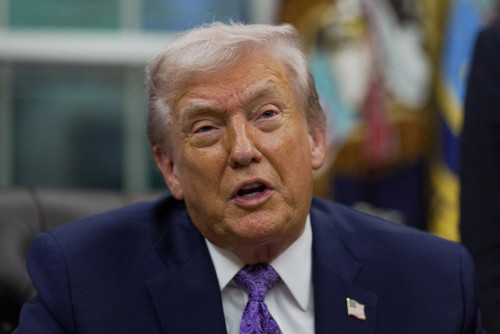By Hannah Lang
(Reuters) -U.S. President Donald Trump on Friday signed a law to create a regulatory regime for U.S.-dollar-pegged cryptocurrencies known as stablecoins, a milestone that could pave the way for the digital assets to become an everyday way to make payments and move money.
The bill, dubbed the GENIUS Act, passed by 308 to 122, receiving support from nearly half the Democratic members and most Republicans.
The law is a huge win for crypto supporters, who have long lobbied for such a regulatory framework in a bid to gain greater legitimacy for an industry that began in 2009 as a digital Wild West famed for its innovation and speculative chaos.
“This signing is a massive validation of your hard work and pioneering spirit,” said Trump at a signing event that included several crypto executives.
Stablecoins are designed to maintain a constant value, usually a 1:1 U.S. dollar peg, and their use has exploded, notably by crypto traders moving funds between tokens. The industry hopes they will enter mainstream use for sending and receiving payments instantly.
The new law requires stablecoins to be backed by liquid assets – such as U.S. dollars and short-term Treasury bills – and for issuers to disclose publicly the composition of their reserves monthly.
Crypto companies and executives have argued such legislation will enhance stablecoins’ credibility and make banks, retailers and consumers more willing to using them to transfer funds instantly.
The stablecoin market, which crypto data provider CoinGecko said is valued at more than $260 billion, could grow to $2 trillion by 2028 under the new law, Standard Chartered bank estimated earlier this year.
The law’s passage culminates a long lobbying effort by the industry, which donated more than $245 million in last year’s elections to aid pro-crypto candidates including Trump, according to Federal Election Commission data.
The Republican president, who has since launched his own coin, in turn aligned himself with the industry and told a crypto conference during his presidential campaign that he would make the U.S. “the crypto capital of the planet.”
But Democrats and critics have said the law should have blocked big tech companies from issuing their own stablecoins, which could increase the clout of an already powerful sector, contained stronger anti-money laundering protections and prohibited foreign stablecoin issuers.
COULD BOOST DEMAND FOR T-BILLS
Big U.S. banks are internally debating an expansion into cryptocurrencies as regulators give stronger backing to digital assets, but banks’ initial steps will be cautious, centering on pilot programs, partnerships or limited crypto trading, Reuters reported in May.
Meanwhile, several crypto firms including Circle and Ripple are seeking banking licenses. This would enable the companies to settle payments faster and cut costs by bypassing intermediary banks, as well as enhancing their legitimacy.
Backers of the bill have said it could potentially give rise to a new source of demand for short-term U.S. government debt, or T-bills, because stablecoin issuers will have to purchase more T-bills to back their assets.
But others worry this activity could increase volatility in the Treasury bills market. In an April research note, JPMorgan analysts estimated that stablecoin issuers could become the third-largest buyer of Treasury bills in the coming years.
TRUMP CREATES BITCOIN RESERVE
Trump has sought to broadly overhaul U.S. cryptocurrency policies, signing an executive order in March establishing a strategic bitcoin reserve.
The president has moved personally into digital assets, launching a meme coin called $TRUMP in January and partly owning crypto company World Liberty Financial.
Democrats in Congress grew increasingly critical of Trump and his family members promoting their personal crypto projects, and their ire threatened to derail the legislation at one point.
The White House has said there are no conflicts of interest for Trump and that his assets are in a trust managed by his children.
(Reporting by Hannah Lang in New York; Editing by Cynthia Osterman and Pete Schroeder)





